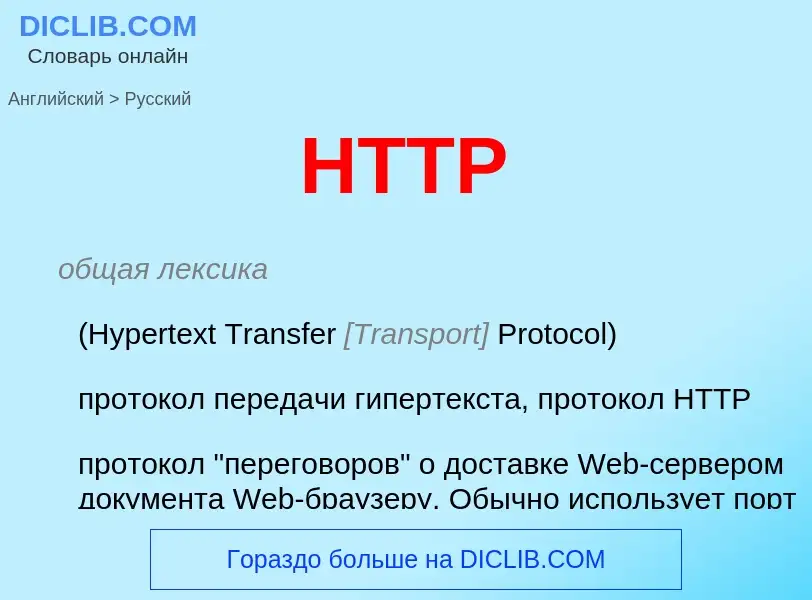ترجمة وتحليل الكلمات عن طريق الذكاء الاصطناعي ChatGPT
في هذه الصفحة يمكنك الحصول على تحليل مفصل لكلمة أو عبارة باستخدام أفضل تقنيات الذكاء الاصطناعي المتوفرة اليوم:
- كيف يتم استخدام الكلمة في اللغة
- تردد الكلمة
- ما إذا كانت الكلمة تستخدم في كثير من الأحيان في اللغة المنطوقة أو المكتوبة
- خيارات الترجمة إلى الروسية أو الإسبانية، على التوالي
- أمثلة على استخدام الكلمة (عدة عبارات مع الترجمة)
- أصل الكلمة
HTTP - ترجمة إلى إنجليزي
общая лексика
(Hypertext Transfer [Transport] Protocol)
протокол передачи гипертекста, протокол HTTP
протокол "переговоров" о доставке Web-сервером документа Web-браузеру. Обычно использует порт 80. Основной протокол WWW, определённый в RFC 2068 и 2616, с помощью которого HTML-документы пересылаются по Интернету от узла к узлу. Его развитие - HTTP+
Смотрите также
Смотрите также
общая лексика
Security Hypertext Transfer Protocol
протокол защищенной пересылки гипертекста, протокол S-HTTP
спецификация защиты данных, разработанная фирмой Enterprise Integration Technology (EIT)
Смотрите также
ويكيبيديا
The Hypertext Transfer Protocol (HTTP) is an application layer protocol in the Internet protocol suite model for distributed, collaborative, hypermedia information systems. HTTP is the foundation of data communication for the World Wide Web, where hypertext documents include hyperlinks to other resources that the user can easily access, for example by a mouse click or by tapping the screen in a web browser.
Development of HTTP was initiated by Tim Berners-Lee at CERN in 1989 and summarized in a simple document describing the behavior of a client and a server using the first HTTP protocol version that was named 0.9.
That first version of HTTP protocol soon evolved into a more elaborated version that was the first draft toward a far future version 1.0.
Development of early HTTP Requests for Comments (RFCs) started a few years later and it was a coordinated effort by the Internet Engineering Task Force (IETF) and the World Wide Web Consortium (W3C), with work later moving to the IETF.
HTTP/1 was finalized and fully documented (as version 1.0) in 1996. It evolved (as version 1.1) in 1997 and then its specifications were updated in 1999, 2014, and 2022.
Its secure variant named HTTPS is used by more than 80% of websites.
HTTP/2, published in 2015, provides a more efficient expression of HTTP's semantics "on the wire". It is now used by 41% of websites and supported by almost all web browsers (over 97% of users). It is also supported by major web servers over Transport Layer Security (TLS) using an Application-Layer Protocol Negotiation (ALPN) extension where TLS 1.2 or newer is required.
HTTP/3, the successor to HTTP/2, was published in 2022. It is now used by over 25% of websites and is supported by many web browsers (over 75% of users). HTTP/3 uses QUIC instead of TCP for the underlying transport protocol. Like HTTP/2, it does not obsolesce previous major versions of the protocol. Support for HTTP/3 was added to Cloudflare and Google Chrome first, and is also enabled in Firefox. HTTP/3 has lower latency for real-world web pages, if enabled on the server, load faster than with HTTP/2, and even faster than HTTP/1.1, in some cases over 3× faster than HTTP/1.1 (which is still commonly only enabled).

![response]] header section, and response body are highlighted. response]] header section, and response body are highlighted.](https://commons.wikimedia.org/wiki/Special:FilePath/Http request telnet ubuntu.png?width=200)
![[[Tim Berners-Lee]] [[Tim Berners-Lee]]](https://commons.wikimedia.org/wiki/Special:FilePath/Tim Berners-Lee CP 2.jpg?width=200)
